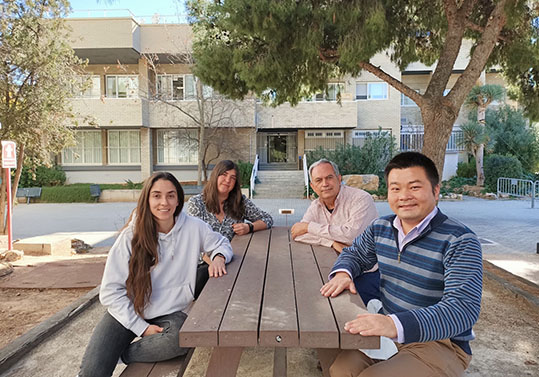
A research team from the University of Valencia led by Juan Ferré, Professor of Genetics, has applied in vivo a new technique to study the competition between two different molecules (or ligands) for the same receptor. This study overcomes the drawbacks of in vitro studies (carried out in a test tube or controlled environment outside an organism) that do not reflect the real situation due to the action of factors that cannot be simulated in a test tube.
Ligands are molecules that send a signal by binding to proteins, also called targets or receptors (large, complex molecules that do most of the work in cells and are necessary for the structure, function, and regulation of the body’s tissues and organs). By binding, the ligands provide information about the affinity with their receptors, their abundance and existence in other similar molecules.
In this research, two ligands –one with insecticidal activity and the other without function– are supplied to caterpillars of agricultural pest species to find out if they both share the same target or if, on the contrary, each ligand has a different receptor. It is observed that the excess of one of these molecules interferes with the action of the other, blocks it and prevents it from exercising its biological function of killing the caterpillar.
The UV research group has applied this discovery in vivo to the receptors of some proteins with insecticidal activity called Cry1 or Vip3 of the bacterium Bacillus thuringiensis. In the assay, insects are given a lethal dose of the insecticidal protein to be tested (ligands) together with increasing amounts of the competing (dysfunctional) protein. This is due to the fact that in order to work with insecticidal proteins, variants must be created that have lost their insecticidal activity, but that maintain their receptor-binding capacity intact, since if they had this activity, the real reason of the death of the caterpillars would be unknown.
The study shows that if insect mortality is not altered after a growing increase in the dysfunctional protein, both proteins (the functional one with insecticidal activity and the dysfunctional one) have different targets. On the other hand, if the protein that has no function reduces the toxicity of the insecticidal protein, both proteins share the same target, that is, the dysfunctional protein blocks the insecticidal protein and reduces its effects. Thus, the effectiveness of the competition between different ligands for binding to the same receptor is quantitatively compared and information is obtained on their relative affinity.
If this type of in vivo assays are complemented with those carried out in vitro, more elaborate models of binding of ligands to receptors can be obtained.
Source:
Hernández-Martínez, P; Bretsnyder, EC; Baum, JA; Haas, JA; Head, GP; Jerga, A; Ferré, J (2022). Comparison of in vitro and in vivo binding site competition of Bacillus thuringiensis Cry1 proteins in two important maize pests. Pest Management Science doi: 10.1002/ps.6763
Lázaro-Berenguer, M; Quan, Y; Hernández-Martínez, P; Ferré, J (2022). In vivo competition assays between Vip3 proteins confirm the occurrence of shared binding sites in Spodoptera littoralis. Scientific Reports doi: 10.1038/s41598-022-08633-y (enlace: https://rdcu.be/cJaZw)
.png)






